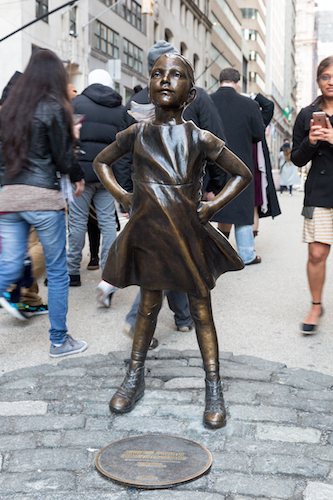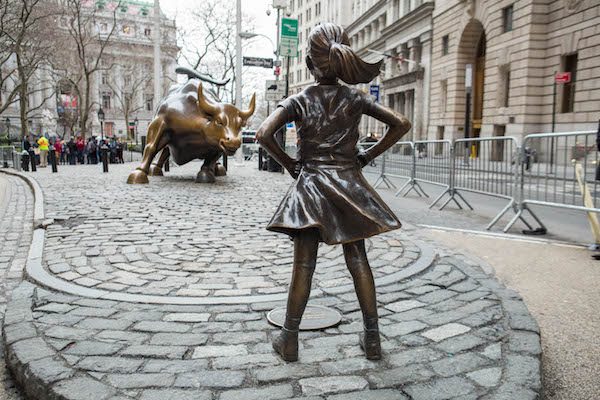A little over a month ago, Kristen Visbal's Fearless Girl statue was placed face to face with Charging Bull statue in Manhattan's Financial District:


But she wasn't just the fearless young woman standing up to capitalism she seems to be. A plaque was placed next to her that read:
Know the power of women in leadership
SHE makes a difference.
State Street Global Advisors
The plaque said "State Street Global Advisors" and emphasized the word "SHE" because Fearless Girl was commissioned by State Street Global Advisors as an advertisement for their SHE index ETF. A lot of people, including the bull's artist, are upset because Fearless Girl's origins are partially related to an advertisement.
Interestingly, Fearless Girl and its plaque were rather ineffective as an ad. (The plaque has now been taken down.) It certainly looks weird to have something that says "State Street Global Advisors" on it by the statue, but it's not at all obvious that this is a reference to the SHE ticker. When I asked people who saw it in person, most of them told me they saw a strong young woman standing up against capitalism. When I myself moved closer and saw the plaque, I felt my eyes roll because it felt like a poor effort on behalf of a finance company to promote women. I didn't recognize it as a publicity stunt for a ticker, and I work in finance. The average visitor is probably much less likely to realize "SHE" meant the ticker. I actually only know a few people who recognized the reference to State Street's ticker, and they all specifically pay attention to new financial products as part of their job. It took the internet to explain the ad to the masses, and it seemed to have gone viral in a way that didn't benefit State Street unless you really, truly believe that all press is good press.
Honestly, I don't love that this otherwise wonderful statue started as an ad; I'd love it a little bit more if it weren't one. However, public art is incredibly expensive to create - Arturo Di Modica spent $350,000 of his own money to create Charging Bull. Not everyone is independently wealthy enough to have a whopping 350 thousand dollars in 1989, which is roughly 700 thousand dollars today, around to drop on a statue that they don't even expect to see returns on. If we believe that "true" art is self-funded, we let art only be the domain of the rich and lose the viewpoints of everyone who doesn't have that kind of privilege. That isn't right.
Di Modica is upset not just because Fearless Girl was in part an advertisement: he is also upset that people are misinterpreting his Charging Bull. He says his statue is about "the strength and power of the American people" and does not like that people view it differently. Specifically, he does not like that some people interpret the bull as the strength and power of capitalism or men in the United States. But once you release your art into the world, your intentions as the artist no longer comprise the only valid interpretation of your art. You cannot control how people react to your art, nor should you be allowed to.
Greg Fallis is one of those people who thinks Di Modica has a point about how authorial intent relates to both Di Modica's Charging Bull and Visbal's Fearless Girl. He writes:
Fearless Girl also changes the meaning of Charging Bull. Instead of being a symbol of "the strength and power of the American people" as Di Modica intended, it's now seen as an aggressive threat to women and girls — a symbol of patriarchal oppression.
Fallis notes that Fearless Girl highlighted the interpretation of Charging Bull as "a symbol of patriarchal oppression" as a valid interpretation. He shows that he understands that authorial intent isn't everything. He continues:
In effect, Fearless Girl has appropriated the strength and power of Charging Bull. Of course Di Modica is outraged by that. A global investment firm has used a global advertising firm to create a faux work of guerrilla art to subvert and change the meaning of his actual work of guerrilla art. That would piss off any artist.
See? It's not as simple as it seems on the surface. It's especially complicated for somebody (like me, for example) who appreciates the notion of appropriation in art. I've engaged in a wee bit of appropriation my ownself. Appropriation art is, almost by definition, subversive - and subversion is (also almost by definition) usually the province of marginalized populations attempting to undermine the social order maintained by tradition and the establishments of power. In the case of Fearless Girl, however, the subversion is being done by global corporatists as part of a marketing campaign. That makes it hard to cheer them on. There's some serious irony here.
Fallis's belief that subverting Charging Bull as "a symbol of patriarchal oppression" should solely be the "province of marginalized populations attempting to undermine the social order maintained by tradition and the establishments of power" leaves no room for works funded for corporate interests. Specifically, he states that the "global corporatists" who funded Fearless Girl as "part of a marketing campaign" invalidates it as subversive art. He implies that it only disrespects Di Modica's statue because it has, as Fallis later states, "hijacked the meaning of his work" under false pretenses.
What Fallis is really saying is that it's valid to see Charging Bull in lenses other than Di Modica's authorial intent, but Fearless Girl will always primarily be marred by its associations to State Street's SHE index ETF. Not only does this imply that some concept of authorial intent has to be the primary interpretation of Fearless Girl, but that the authorial intent of Fearless Girl is solely the province of State Street and is thus completely disconnected from its creator, Kristen Visbal.
While it's true that Kristen Visbal's Fearless Girl was funded by State Street, it is equally true that Visbal wove her own vision of the girl into the statue. Visbal put careful thought into the girl's expression:
"But I made sure to keep her features soft; she's not defiant, she's brave, proud and strong, not belligerent."
She made a deliberate choice as to who the girl should represent:
The sculptor based her work on two Delaware children - a friend's daughter she said had "great style and a great stance, and I told her to pretend she was facing a bull." The second was a "beautiful Latina girl, so everyone could relate to the Fearless Girl."
Removing Visbal's creativity from an examination of the authorial intent behind Fearless Girl just doesn't make sense. Whatever value authorial intent holds aside, her creative decisions undoubtedly influenced why I relate to a girl proud to face capitalism and take on Wall Street.
Later in his piece, Fallis focuses even more on State Street's intentions when trying to evaluate the merits of Fearless Girl:
And yet, there she is, the Fearless Girl. I love the little statue of the girl in the Peter Pan pose. And I resent that she's a marketing tool. I love that she actually IS inspiring to young women and girls. And I resent that she's a fraud. I love that she exists. And I resent the reasons she was created.
On its surface, this paragraph sounds like an understandable set of mixed feelings on the piece that I largely agree with, but Fallis hides something much, much more insidious - the idea that Fearless Girl is a "fraud" because State Street funded her creation.
Calling the girl a "fraud" has deeper underpinnings than only the unjust idea that getting funding invalidates art mentioned above. Women's ideas have been erased by men who restate their ideas, take get credit for them, and successfully erase women's involvement in them - much as Visbal's creative decisions are being erased because State Street funded her sculpture. Women's contributions have been consistently devalued because they have been supported by the money of others, usually men who collectively hold the keys to significantly more money than women do - much like how Di Modica's self-funded $350,000 work is considered true guerilla art while Visbal's has no such value because she didn't pay for it herself. Finally, as much as it pains me to say it, women's progress often depends on the approval of men and their willingness to take up their cause - much as State Street chose to fund Visbal's work.
Do I think we should stop thinking critically about Fearless Girl? Absolutely not, but I definitely think we can't consider the context surrounding how the statues were funded and their authorial intents in a vacuum - they are fundamentally intertwined with the patriarchy.